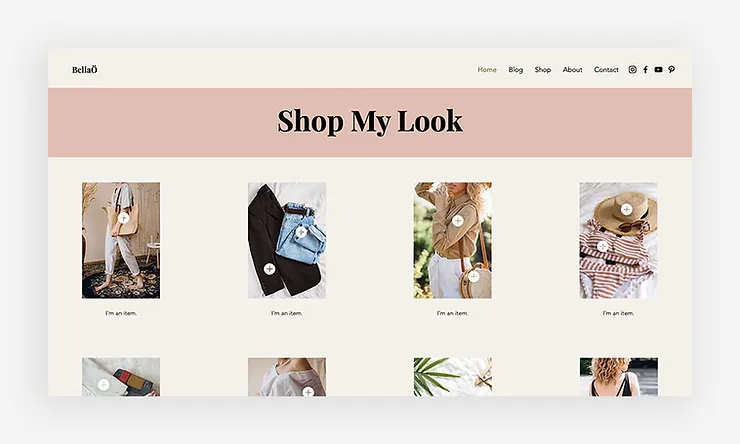Wondering How to Start a Blog? Well, you’ve come to the right place. As a blogger, I can tell you that it’s a rewarding way to improve your writing skills, develop new ideas, and build an online presence centered around your passions and expertise. You have the opportunity to inspire, inform and entertain your readers – and as your blog grows, you can even make money from it and turn it into a full-time job.
In other words, blogging is the first step on the path to your dream job or favorite hobby – so you can’t go wrong. While starting a blog may seem daunting, I’ll walk you through each step to make it as smooth and successful as possible. The process is actually quite simple, and you’ll be able to get your blog up and running in no time.
Table of Contents
In this step-by-step guide, you’ll find all the instructions and tools you need to start a blog. You’ll learn how to get your website up and running, write your first blog post, and gain loyal readers. Sound exciting? Let’s dive in.
Quick Overview on How to Start a Blog
In this complete guide to blogging from A to Z, we’ll go over everything from choosing your blogging platform to making money from your written work. With a little guidance, you can get your blog online in 30 minutes or less.
This is the most comprehensive guide you will find on building a successful blog from scratch. However, if you want to start a blog quickly, you can use the numbered steps above as a cheat sheet. You can go straight to the step you need the most help with, or grab a cup of coffee and read it all the way through.
What is a Blog?
A blog can encompass an entire website, or it can simply be a separate section of a website where you publish content on a topic that particularly interests you. A blog typically contains both written and visual elements, published in an easy-to-read article format so visitors can quickly browse and find what they’re looking for.
And with over 31.7 million blogs in the U.S. alone, you can literally find blogs on any topic, from home renovation to baking to marketing strategies for local businesses. Once you’ve built a community of readers, the possibilities are truly endless.
Why Start a Blog?
People start blogs for a variety of reasons, some of which include:
Now that you have a better understanding of the reasons to start a blog, let’s explore the steps you need to take to create a blog – from idea to publication.
1. Choose a Blogging Platform
The first step in starting a blog is choosing a blogging platform or content management system (CMS) to publish your content. A quick Google search will show you that there are several different sites that are suitable for bloggers in all industries. I recommend Wix because it is a good all-around blogging platform that will meet most needs.
Wix’s blogging platform is quite easy to use and offers a variety of attractive design options and templates for you to work with. It also has features to analyze your blog’s performance and monetize your content, which will come in handy when you set up your blog and build your readership.
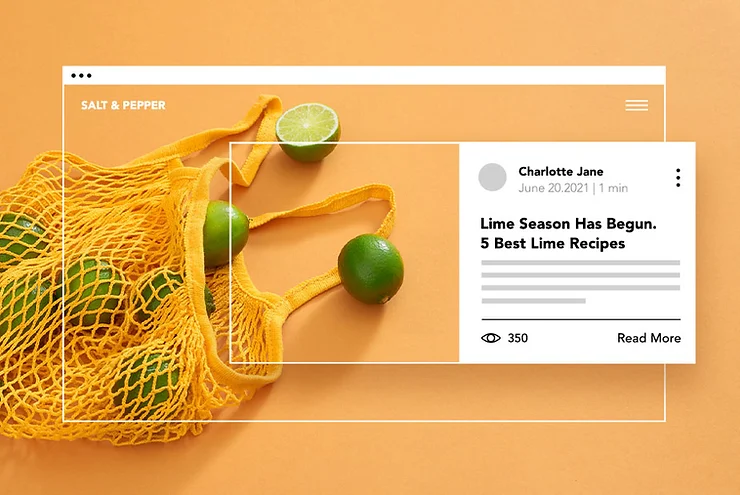
How Much Does It Cost to Start a Blog?
One of the most common questions people ask when researching starting a blog is the cost. On many platforms, starting a blog is completely free.
You can always decide to upgrade to different plans depending on your budget and needs.
2. Pick a Hosting Platform
Once you have chosen your preferred blogging platform, you need to decide on a hosting platform. A blog, like other types of websites, needs a hoster. This host stores the websites on a server at a unique address so that visitors can easily reach them.
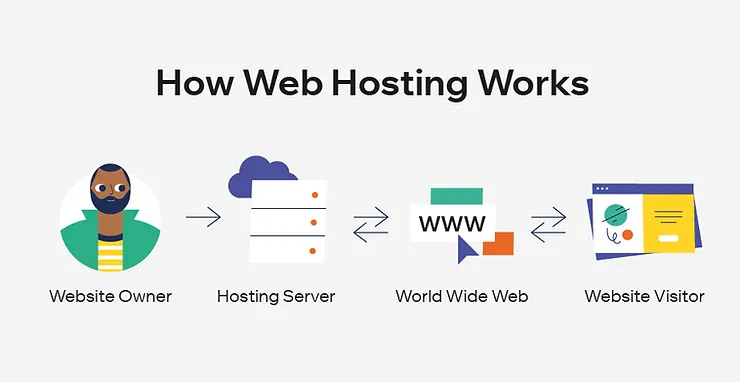
With some blogging platforms, hosting is already included, so you don’t have to look for a separate web host when setting up your blog. In this case, you can skip this step and go to Step 3.
With other website builders, such as WordPress, you will need to find and pay for a separate web hosting platform. Some popular options are:
- BlueHost
- HostGator
- GoDaddy
- DreamHost
If you are not sure which web hosting platform to choose, you should consider these factors:
Once you’ve decided on a blogging platform and hosting provider, you can start developing your blog idea.
Don’t worry about choosing and registering your domain name just yet. We’ll go through this process together in Step 4.
3. Find the Right Profitable Blog Niche
Let’s leave the technical behind and turn to the theoretical. Take a step back and think about the most important element that will form the basis of your blog, from the URL and domain name to the content and design: your blog’s niche. What exactly do you want your blog to be about?
There are practically no limits to the topics you can choose. What matters is that you decide on a specific topic area that will be the focus of your entire blog and its content strategy.
Possible blog types range from fashion blogs to marketing blogs to book blogs to food blogs. Since there are many other blogs out there covering the same topics, you need to find a way to stand out from the crowd and still write about what you love.
Here are three simple steps to finding the perfect blog niche – one that not only matches your passions but that you can monetize and grow:
- Narrow Down Your Interests
- Research Your Audience
- Check to See if it’s Profitable
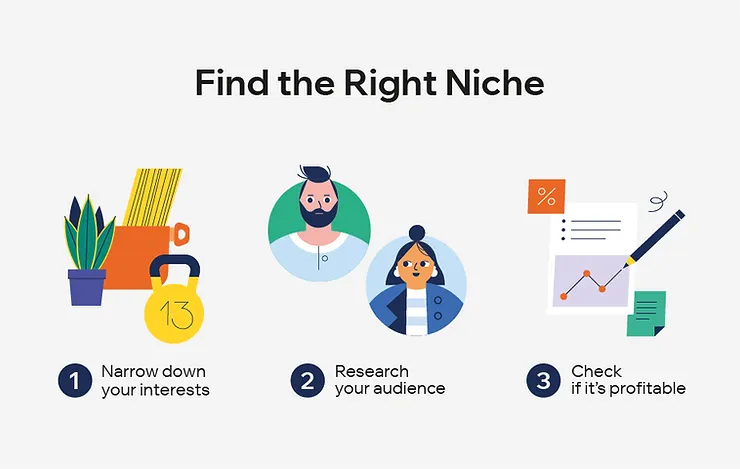
Narrow Down Your Interests
When you start a blog, think long-term. To motivate yourself to blog regularly, you need to write about something that really interests you. If you choose a topic just because it’s popular or profitable, your efforts will fall flat pretty quickly, as will your entire blog content strategy.
If you don’t know what to blog about right off the bat, that’s not a problem. Start by simply brainstorming topics you like. What do you like to talk about? What are you dying to learn more about?
Now write down the first five to 10 topics that come to mind. For this example, say:
- Travel
- Cooking
- Family
- Music
- Hiking
Then think about what specific interests you have within those topics and add them to your list. Your additions might look something like this:
- Backpacking in Southeast Asia
- Vegan Recipes
- Raising Twins
- Indie Rock Music
- Hiking in the Rocky Mountains
Don’t worry yet that these niches are perfect. You’ll explore them more thoroughly in the next steps. (However, if you’re looking for inspiration, check out how these popular art blogs use their platforms to connect with audiences who share a similar passion.)
Research Your Audience
The next step in starting and creating a blog is to find out what topics people like to read about. As your blog gains momentum, you can eventually make money from it and become a full-time blogger.
With a little market research, you can determine the demand for a particular niche. First, take a look at Google Trends, where you can see how many people are searching for a particular topic. The more searches a topic gets, the greater the public demand for it.
For example, let’s enter “vegan recipes” into Google Trends. In the image below, you can see that interest in this topic is relatively constant, making it a good fit for a blog niche.

“Paleo recipes,” on the other hand, attracts much less interest. That doesn’t mean it’s a bad idea – some bloggers prefer to write for a more specific audience if they have a unique specialty – but it does mean that there are fewer people interested in that particular topic area.
If Google Trends shows that interest in a topic area is either very low or declining, then it’s unlikely that topic will gain traction.
Check if It’s Profitable
Whether you’re running a personal or professional blog, you should consider whether your niche is profitable. Even if you want to start as a hobby blogger or create a fan website, you should think about future earning opportunities in case your blogging efforts develop into a career.
There are several ways to make money as a blogger, but one of the most common methods is affiliate marketing. As an affiliate, you work with a specific company, provide a link to their products on your blog, and receive a commission for each sale made through your site.
Considering blogging as an affiliate is a great way to find out if your niche is profitable. Consider what kind of “best of” or “how to” posts you could write. For example, “The best kitchen tools for easy cooking” or “How to make carrot cake in 10 minutes.” In both cases, you could include an affiliate link to your favorite food processor or electric mixer and earn money for each purchase made through your blog.
You don’t need to plan your money-making strategy yet, but general thoughts on profitable opportunities can help you choose a niche. For now, focus on starting your blog – we’ll talk more about making money with blogs in Step 10.
4. Select a Blog Name & Domain
When you think about how to create a blog, you probably ask yourself what to call it.
There are three ways you can choose the name of your blog. These include:
- Your First & Last Name
- The Name of Your Business (If You Have One)
- A Creative New Name
When choosing a name for your blog, you should also think about the personality you want it to express. Do you want it to be formal and professional? Sweet and romantic? Fancy and unconventional? If you can’t decide what to call your blog, this blog name generator is a helpful source of inspiration.
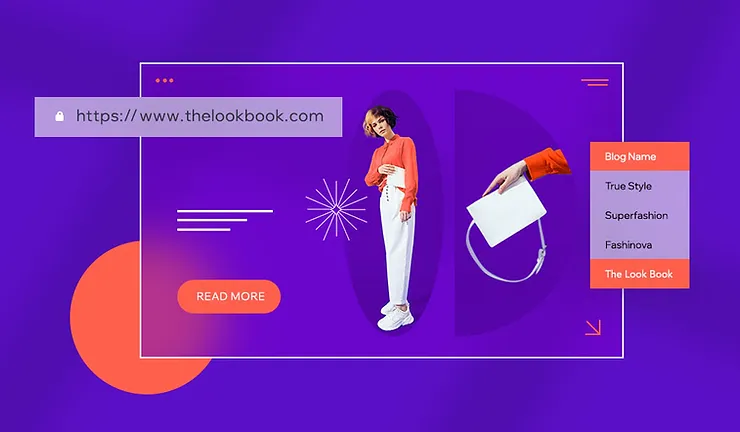
Once you have decided, you should also choose a domain name for your blog. A domain is also called a URL and is the address of a website on the Internet. Usually, your domain name will be the same as the name of your blog, or at least influenced by it.
5. Set Up & Design Your Blog
- Choose a Blog Template
- Decide Which Pages to Include
- Indexing in Search Engines
- Create a Blog Logo
At this point, you’ve chosen a blog and hosting platform, a domain name, and a blog niche. Now you have all the basics in place to set up your blog. Below, you’ll learn how to optimize your blog design:
Choose a Blog Template
The first part of setting up a blog is choosing a template. Like the name of your blog, its look is an important part of its personality.
The most efficient way to get your blog up and running is to choose a pre-made blog template. Then, you can customize it to your liking.
Be sure to choose a template that reflects the subject area of your blog. There are website templates for bloggers of every genre, whether you’re a food blogger, a photography blogger, or a business blogger. As you browse, think about the mood you want your website to convey, such as whether it’s classic, modern, rugged, or minimalist.
You should also keep this in mind when further personalizing the template with your preferred colors. Color psychology plays a big role in the impression your audience has of your blog. When choosing a color palette, think about the feelings and attitudes that different colors evoke. For example, blue represents reliability and confidence, while yellow exudes energy and joy.
If you’re not sure which templates to choose, these blog examples will serve as a helpful source of design inspiration.

Decide Which Pages to Include
Once you’ve decided on a template, consider which pages you want to include. Most blogs include more than just an area to display their posts. They may also include an online store, as in the image below, or a contact page.

Here is an overview of the different options when designing your blog:
If you want to add even more pages to your blog, “Tutorials,” “Hot Topics,” or “Author’s Picks” pages are popular options.
Also, some blogs choose to publish their posts directly on the homepage, while others keep their home pages and blog pages separate. In this case, make sure you include a navigation menu so visitors can easily reach your blog and all other pages.
There is no right or wrong way to set up a blog. Just try out different options to find out what best suits your style and personality. Remember that you can always add or remove pages over time as your blog evolves.
Get Indexed on Search Engines
Another part of starting a blog is making sure it’s visible on Google and other search engines. This is crucial if you want your content to show up in search results, so you should take care of this step right away.
First, make sure that your website is indexed on Google. This essentially means that you need to let Google know that your blog exists. You can do this by submitting your sitemap to Google Search Console.
Pro Tip:
Google Search Console is not only important for indexing your website, but it is also a valuable platform that you will use throughout your blogging journey. It provides you with important data about your blog’s visitors and clicks that you can use to improve your content.
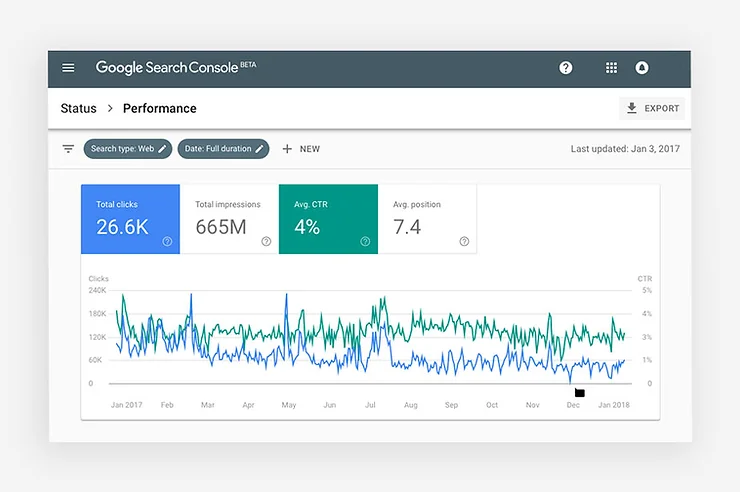
To find out if your site is already in Google’s search index, perform a quick site search (a site search uses your homepage URL and takes the form site:yourblogname.com). If your blog shows up in the search results, then your site is already indexed.
Create a Blog Logo
Finally, you should round off your website with an attractive blog logo. This is another way to add personality to your website and an essential step if you want to create a blog that will become a recognizable brand.
One option is to design your own logo or outsource this task, but you can also use an online logo maker. These tools give you plenty of leeway to customize your logo with your preferred colors, fonts, and icons and are usually faster and less expensive than hiring a professional designer.
Once you’ve created your logo, place it in the top left corner of your website and link it to your homepage. This will help brand your content while making it easier for readers to navigate.
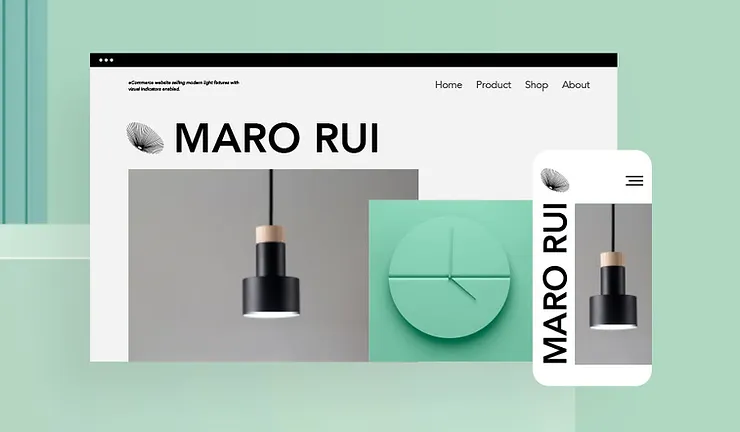
6. Brainstorm Blog Topics
As for the technical side, your blog is now set up and ready to go. Now it’s time to think about what topics you want to start with.
First, think about your experiences, successes, failures, or discoveries related to your niche. What insights can you share? What ideas do you want to explore in depth?
Try to put yourself in your readers’ minds as you think about topics. Here are some questions that can help you brainstorm ideas:
- What Characteristics Does My Target Audience Have?
- What Topics Does My Target Audience Get Excited About?
- What Challenges Does My Target Audience Face?
You can also develop your ideas using the topic cluster model. This is essentially a tightly organized system where related posts are linked together through a series of internal links. While this process is usually considered part of search engine optimization, you can also think of it as a mind map for brainstorming.
For this model, think of an overarching topic, such as recipes, and then break it down into smaller subtopics, such as recipes for dinner or brunch. Then break these down into even more specific topics, such as 20-minute dinner recipes, mimosa recipes, and cake decorating ideas. Each of these topics could be its own blog post.
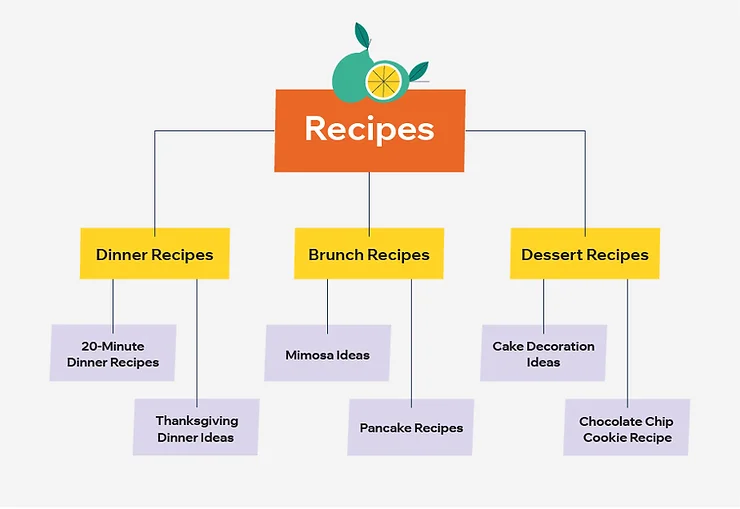
If you’re still stuck, this list of blog ideas can help you brainstorm. It includes:
- A 30-Before-30 list (Also 40-Before-40, or 50-Before-50).
- Your Sources of Inspiration
- How-to Guides for Beginners
- Time-Saving Hacks
- A Challenge You’ve Mastered
Let these ideas guide you, but feel free to add your own creative touch tailored to your niche.
7. Write Your First Blog Post
- Start with Keyword Research
- Draft a Title for your Blog Post
- Outline your Key Points
- Write Engaging Content
- Insert Images
- Optimize for SEO
- Edit & Publish
Now that you’ve gathered ideas, you can start writing. Below you will learn how to write a blog post from start to finish:
Start With Keyword Research
Finding the right keywords is crucial to getting people to read your posts. By targeting specific terms with your article, you increase the likelihood that your blog will appear on search results pages for those queries.
For example, let’s say you want to post a carrot cake recipe on your blog. Then you should target keywords like:
- Carrot Cake
- Carrot Cake Recipe
- Best Carrot Cake Recipe
- How to Make Carrot Cake
Depending on the topic, some keywords are more obvious than others. You can refine your keywords with free keyword research tools like Google Keyword Planner, or you can use more robust paid options like SEMrush or Ahrefs.
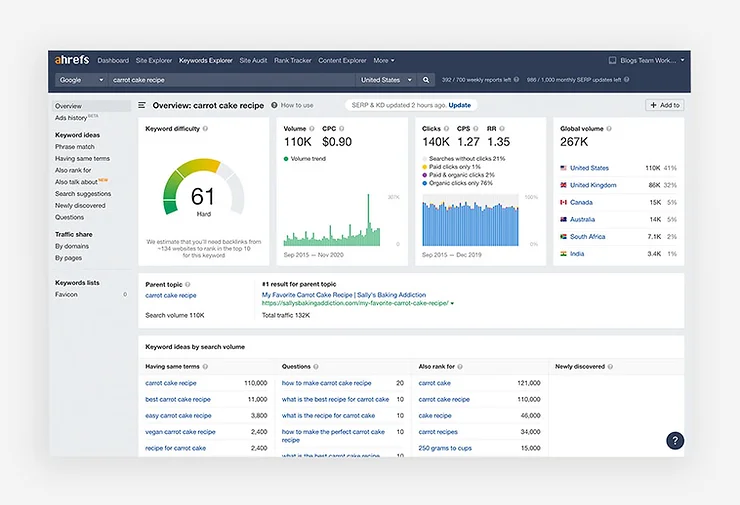
Next, you need to strategically use the selected keywords in your article. This means two things: first, you need to sprinkle these terms throughout your article (but try to do this as organically as possible – no one likes unnatural keyword stuffing). Second, you should structure your article based on the format you see in the top 10 search results for these keywords (you can also refer to these results when deciding how long a blog post should be).
For example, let’s say you want to write an article about your favorite carrot cake recipe. Start by checking your competitors – the top 10 search results on Google for the keyword “carrot cake recipe“.
If you type this term into the search engine, you will notice that the top results are written in the form of numbered steps, not a story. So, you can assume that most readers prefer the list format for these types of posts. To provide valuable content to your readers – and thus rank high on Google – you should write your own post in a similar format.
Likewise, you should address all of your competitors’ key points. This doesn’t mean you can’t be creative. It just means that you should not only share your own insights, but also cover all the bases.
Outline Your Main Points
Researching keywords will give you an idea of the best format for your blog post and what sections to include. This naturally leads into the outlining phase of the writing process.
First, choose the type of blog post you want to write. Will it be a how-to guide? A product recommendation? An opinion piece? Regardless of which blog post template you choose, you should have a clear idea in mind before creating the outline.
Then, use headings and subheadings to divide your content into organized, bite-sized sections. Under each heading, jot down the main points you will cover in each section. This will be the basic outline of your first blog post.
You can use this downloadable blog post template to create your outline. All you need to do is fill in the blanks:
Come Up With a Blog Post Title
The next step in writing a blog article is to come up with a descriptive title. You can come up with your blog title at any stage of the planning process, but the best ideas often come when you’re creating your outline.
A blog title is a small but powerful piece of content. It often determines whether or not someone will click on your article.
Put yourself in your readers’ shoes to make your blog titles memorable and compelling. Think about what might interest and excite them, and try the following strategies:
- Be Clear & Direct
- Promise Added Value
- Appeal to your Reader’s Emotions
- Arouse Their Curiosity
- Use Humor, Alliteration, or Wordplay
Here are a few ideas for blog titles you can fill in:
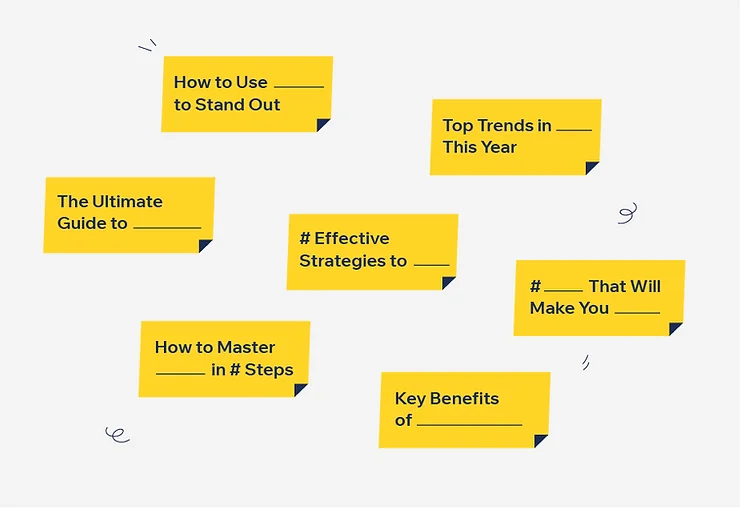
Here’s more information on how to write a headline that stands out. If you want to learn more about what makes a successful headline, the Buzzsumo study on common headlines is also an insightful resource.
Write Engaging Content
Now it’s time to start typing. Remember that you need an introduction, text organized by headings and subheadings, and a conclusion (optional).
In the introduction, grab your audience’s attention with a compelling anecdote, powerful quote, statistic, or interesting fact. Then, briefly summarize what the article is about and make sure to pique your readers’ interest.
Then write the main text, using your outline as a guide. This is where you share your knowledge and experience as a blogger. Make sure you don’t write platitudes; writing for the sake of writing is one of the biggest mistakes in blogging. Instead, make sure each sentence is meaningful, and go straight to your original insights and actionable tips. You should also use a tone of voice that resonates with your audience, whether it’s witty and casual or serious and formal.
Finally, you should round out the post with a closing section. While this final part isn’t included in every blog, it’s a great way to summarize your ideas and share your concluding thoughts.
Remember that writing a blog post can take several hours, and it is a process that should not be rushed. Set aside at least half a day to write your first draft.
There are faster ways to research, plan and create blog content if you choose AI tools for content creation. There are several to choose from – including Chat GPT from Open AI, BARD from Google, and others like Jasper.ai. Just make sure you thoroughly review the AI-generated content, fact-check it, and don’t forget to give the content your own voice and style.
Insert Images
At the beginning of your blog, remember that the choice of images can strengthen the reader’s overall impression of your article. Whether you add photos, screenshots, or illustrations to your articles, they should be both functional and beautiful. Make sure they convey your main messages and highlight important examples in the article.
If you don’t have your own images, start by looking at free stock photos online. Pexels and Unsplash are both popular sites for gathering imagery. Although you may want to use your own photos later, stock photos are a quick way to get your blog started.
Optimize for SEO
Once you’ve created your content, there are a few things you need to take care of before you hit publish. These steps are primarily about strategy, from improving your blog SEO to generating conversions from your article. Below is a quick checklist for writing posts:

Edit & Publish
You now have everything you need to write your first blog post. Read it a few times and share it with family members or friends so they can review it. It’s always helpful to have a second, third, or fourth pair of eyes.
When you think your article is ready, upload it to your blog. On your blog platform, you will also find a place to enter the metadata and URL. Once that’s done, click Publish and let yourself be celebrated.
8. Create an Editorial Calendar
Whew! You just wrote your first blog post. Take a break, and when you’re ready, schedule posts for the rest of the month.
Creating an editorial calendar is an important part of starting a blog. This way, you can make sure you’re posting content regularly, holding yourself accountable as a writer, and not straying from your blog goals. Your readers want new content, and you need to deliver it. Also, search engines take into account how frequently you publish content when determining your site’s overall ranking.
You probably already have a handful of topics from your brainstorming session in Step 6, but if not, use the same process to come up with new ideas. Once you have at least 10 or more ideas, start creating a content calendar.
Your calendar doesn’t have to cost anything, and you don’t have to use unfamiliar tools or platforms. Open Excel or Google Sheets, and start creating a calendar. Which columns you use is entirely up to you, but you’ll probably want to create different sections for the publication date, blog title, main keywords, article status, and comments.
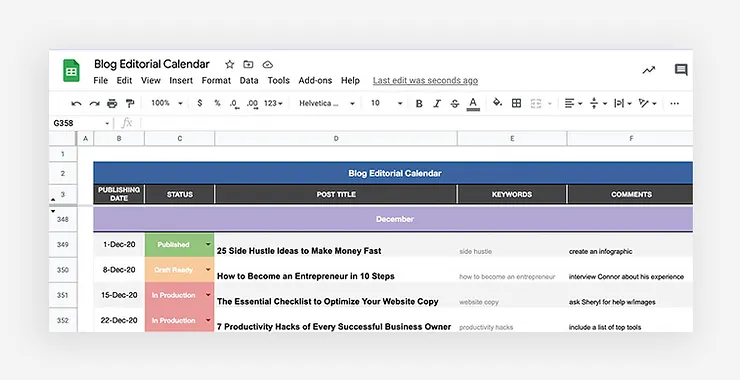
Pro Tip:
If you know you’re prone to procrastination (aren’t we all?), open a Google Calendar and enter your deadlines there. You can even set aside blocks of time in your calendar for writing.
How Often Should You Blog?
When learning how to start a blog, an important question is how often you should post new content. As a rule of thumb, the more often you blog, the more visitors you’ll get. There is no universal answer to the question of how often you should blog, but studies have pointed us to a few important statistics:

How often you blog also depends on your goals. If your main goal is to get the word out about your brand, you should start with one to two new posts per week. On the other hand, if your primary goal is to increase traffic to your blog, you should ideally write three to four new posts per week.
Keep all of this in mind when creating your editorial calendar, but set small and achievable goals. Setting unrealistic deadlines that you can’t meet will throw you off track and even discourage you.
Once you get used to publishing and make it a habit to stick to your schedule, you can always increase your efforts. Also, remember that you can always bring in guest writers to increase the amount of content you publish each week.
9. Promote Your Blog
- Share on Social Media
- Create a Blog Newsletter
- Write for Other Websites
- Reach Out to An Existing Community
- Participate in Question & Discussion Sites
- Invest in Paid Advertising
- Try Out New Content Formats
At this stage, you have everything you need to start a blog. The final steps are about how to get the word out about your blog and build it into a serious monetization tool.
To attract readers, you need to find creative ways to drive traffic to your site. Improving your search engine optimization is an important step, but the following methods can also help you promote your blog. Keep in mind that most of them are completely free, while some (like advertising) require a fee.

10. Make Money Blogging
- Affiliate Marketing
- Advertise on Your Blog
- Offer Paid Subscriptions
- Write Sponsored Content
- Sell e-books & Merchandising Items
- Offer Consulting Services
If you want to start a blog with a large readership, you probably also want to make money from the popularity of your blog. We’ve mentioned affiliate marketing earlier in this article, but let’s talk more about these and other money-making strategies that can help you generate passive income from your writing efforts.

There are several ways to make money with a blog. Here is a brief overview of each method:
Blogging Resources – How to Become a Blogger
When learning how to create a blog and become a blogger, be sure to browse these blogging resources that will guide you through the writing process, SEO and more:
Blogging Tools
Finally, online tools play an important role in starting a blog, as they streamline the process and make it more efficient. Below is a short list of some helpful blogging tools you can use to start a blog – don’t forget to bookmark them for future reference:
How to Start a Blog Infographic
That’s about it. Finally, here’s a quick infographic:
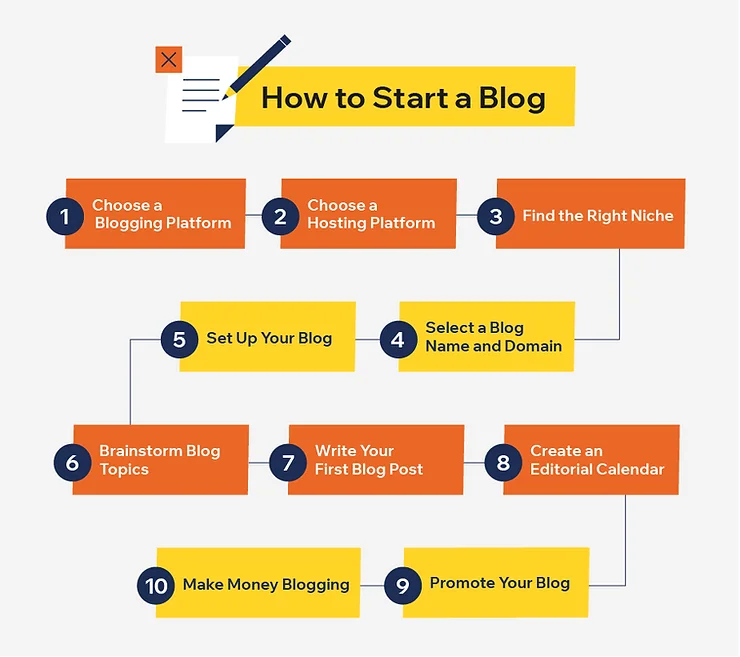
Now you have all the tools and resources you need to start a blog. You couldn’t have found a more rewarding endeavor, and I’m honored to help you bring your blog to life. Bookmark this guide for reference as you begin this new journey, and have fun blogging!

Conclusion
In summary, starting a blog is an exciting and fulfilling endeavor that offers numerous benefits and opportunities. By following the steps outlined in this article, you can embark on a successful blogging journey. Choosing a niche that aligns with your interests and target audience is critical to creating valuable content and building an engaged readership.
Choosing the right blogging platform and setting up your blog is a fundamental step in building your online presence. With the numerous user-friendly platforms available, you can easily create a visually appealing and functional website. Creating compelling content and engaging with your readers are key elements to ensure the success of your blog. By consistently delivering valuable and engaging posts, you can attract and retain a loyal audience.
Promoting your blog and exploring monetization options are essential to increase awareness of your blog and generate potential revenue. Use effective marketing strategies to increase your blog’s reach, and consider different monetization methods such as advertising, sponsored content, or affiliate marketing. With commitment, consistency, and the right strategies, you can sustain your blog’s growth, expand your audience, and achieve long-term success in the blogosphere.
FAQ’s
How Can I Start a Free Blog?
First of all, you need to choose a blogging platform with free user options. Wix, for example, lets you create a blog for free. You can also save money when setting up a blog by writing all the content yourself and using as many free content planning and keyword search tools as possible. In most cases, you can also use free images that are included in the template or editor of your blogging platform.
How Can I Create a Successful Blog?
First of all, you need to define the term “successful“. In general, a successful blog is one that has a large readership and generates a significant number of visitors. But depending on your blog’s niche, the goals of a successful blog may look different. For some bloggers, an engaged readership that shares your content widely and views it as a source of authority and trust is what makes their blog successful. For other bloggers, another indicator of success is how quickly and effectively their blog can be monetized or act as part of their marketing funnel.
Is Blogging Still Worth It?
Yes, blogging is still worth it. Despite the rise of social media platforms and video content, blogging is still a valuable medium for individuals and businesses. Here are some reasons why blogs are still relevant: Unlike social media, a blog gives you full control over content; blogs are still great for building search engine presence and traffic; blogs are still great for building communities and establishing your brand authority; blogs still offer tremendous potential for blog monetization.
How Do You Create a Blogging Website?
To create a blogging website, there are a few steps involved. Once you have decided on a nice blog, you need to create your actual website. Opt for a website builder like Wix, which includes hosting and everything you need to create a blog website.
Arnold Shepard, a tech blogger, has a strong inclination towards cybersecurity. With a degree in computer science and previous work experience in various tech firms, he now focuses entirely on blogging. While covering a broad spectrum of topics, Arnold exhibits a special interest in online security and privacy. His writings offer valuable guidance on the latest dangers and the most effective measures for safeguarding personal information. Arnold’s commitment to raising public awareness about cybersecurity has earned him widespread recognition as a reputable influencer in the technology sector.
To read more similar articles, click here.
Thanks for visiting our Website. If you appreciate our work, kindly show us some support in our comments section 🙂


